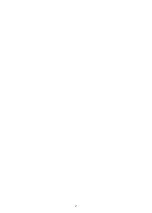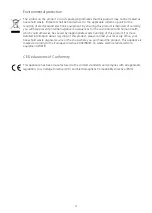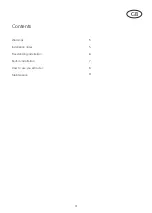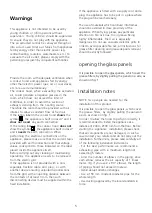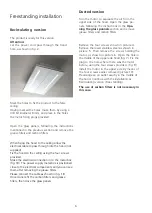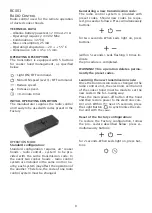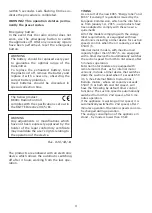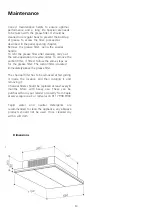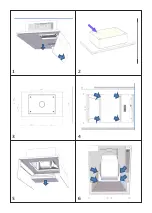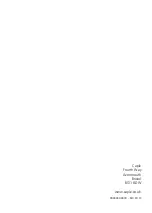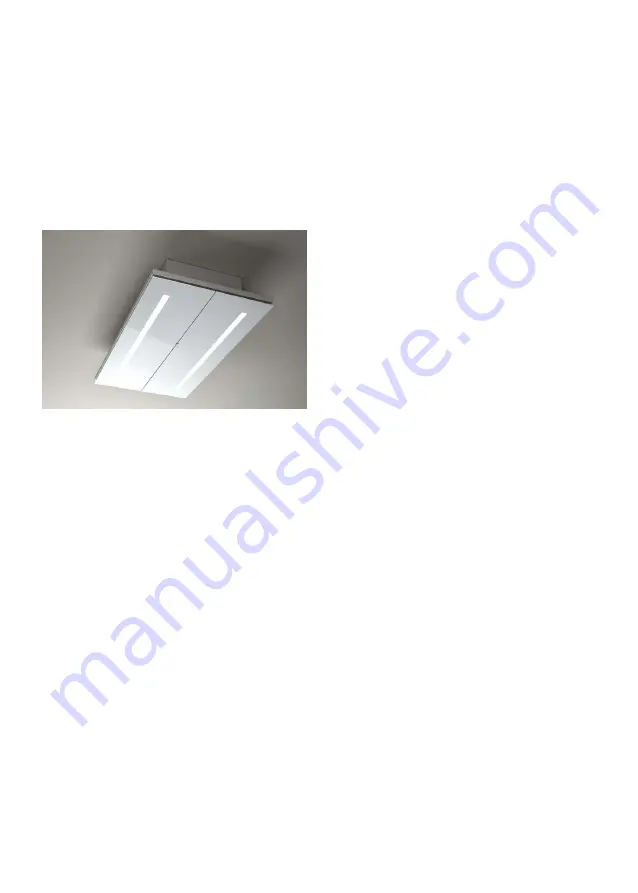
6
Freestanding installation
Recirculating version
The product is ready for this version.
Attention:
Let the power cord pass through the hood
hole, as shown in fig. 2.
Mark the holes to fix the product to the false
ceiling.
Having marked the holes, make them by using a
drill bit (diameter 8mm), and place in the holes
the metric fixing plugs provided.
Open the glass panels, following the instructions
mentioned in the previous section and remove the
grease filters and carbon filters.
Remove the four screws shown in picture 4.
Remove the lower stainless steel as shown in
picture 5. Then remove the screws holding the
motor, as shown in picture 6. Open the hole in
the middle of the upper side hood (fig. 7). Fix the
plug to the hole where there was the motor
before, using the four screws provided. (fig. 9)
Install the motor in the upper side by means of
the four screws earlier removed (picture 10).
Prearrange an air outlet exactly in the middle of
the hood. Continue with the installation as
Recirculating version (Free standing).
The use of carbon filters is not necessary in
this case.
6
Freestanding installation
Recirculating version
The product is ready for this version.
Attention:
Let the power cord pass through the hood
hole, as shown in fig. 2.
Mark the holes to fix the product to the false
ceiling.
Having marked the holes, make them by using a
drill bit (diameter 8mm), and place in the holes
the metric fixing plugs provided.
Open the glass panels, following the instructions
mentioned in the previous section and remove the
grease filters and carbon filters.
Fix the hood on the ceiling and let the electric cable
pass into the hood.
Fix the hood to the ceiling using the four screws
provided.
Make the electrical connection into the metal
box. Refit the carbon filters and the grease filters
and close the glass panels.
Ducted version
Turn the motor to evacuate the air from the
upper side of the hood.
Open the glass panels, following the instructions in
the
Opening the glass pannels
section and
remove grease filters and carbon filters.
Remove the four screws shown in picture 4.
Remove the lower stainless steel as shown in
picture 5. Then remove the screws holding the
motor, as shown in picture 6. Open the hole in
the middle of the upper side hood (fig. 7). Fix the
plug to the hole where there was the motor
before, using the four screws provided. (fig. 9)
Install the motor in the upper side by means of
the four screws earlier removed (picture 10).
Prearrange an air outlet exactly in the middle of
the hood. Continue with the installation as
Recirculating version (Free standing).
The use of carbon filters is not necessary in
this case.
Ducted version
Turn the motor to evacuate the air from the
upper side of the hood. Open the glass pa-
nels, following the instructions in the
Ope-
ning the glass pannels
section and remove
grease filters and carbon filters.
When fixing the hood to the ceiling allow the
electrical cable to pass through into the hood (not
supplied).
Fix the hood to the ceiling using the four screws
provided.
Make the electrical connection in to the metal box
(fig. 18). The power supply metal box is positioned
close to the electrical components and you can see
them after removing the grease filters.
Please connect the cable as shown in fig. 18.
Once done refit the carbon filters and grease
filters, then close the glass panels
Installation of the air outlet with a joint
diameter of 200mm
(NOTE this item is supplied with DDMEXT25
and DDMEXT40 motors only)
In case of a
installation with the air outlet diameter of
200mm, which is possible on the upper
side of this ceiling hood only, please
follow these instructions.
Make the opening for the air outlet diameter of
200mm on the upper side of the product
(this opening is already marked on the body
of the unit).
Install the joint with a diameter of 200mm
supplied with the external motor and fix it
with the 8 screws supplied.
The 200mm diameter joint is moved slightly
from the longitudinal axis of the product by
25mm.
6
Freestanding installation
Recirculating version
The product is ready for this version.
Attention:
Let the power cord pass through the hood
hole, as shown in fig. 2.
Mark the holes to fix the product to the false
ceiling.
Having marked the holes, make them by using a
drill bit (diameter 8mm), and place in the holes
the metric fixing plugs provided.
Open the glass panels, following the instructions
mentioned in the previous section and remove the
grease filters and carbon filters.
Remove the four screws shown in picture 4.
Remove the lower stainless steel as shown in
picture 5. Then remove the screws holding the
motor, as shown in picture 6. Open the hole in
the middle of the upper side hood (fig. 7). Fix the
plug to the hole where there was the motor
before, using the four screws provided. (fig. 9)
Install the motor in the upper side by means of
the four screws earlier removed (picture 10).
Prearrange an air outlet exactly in the middle of
the hood. Continue with the installation as
Recirculating version (Free standing).
The use of carbon filters is not necessary in
this case.
6
Freestanding installation
Recirculating version
The product is ready for this version.
Attention:
Let the power cord pass through the hood
hole, as shown in fig. 2.
Mark the holes to fix the product to the false
ceiling.
Having marked the holes, make them by using a
drill bit (diameter 8mm), and place in the holes
the metric fixing plugs provided.
Open the glass panels, following the instructions
mentioned in the previous section and remove the
grease filters and carbon filters.
Fix the hood on the ceiling and let the electric cable
pass into the hood.
Fix the hood to the ceiling using the four screws
provided.
Make the electrical connection into the metal
box. Refit the carbon filters and the grease filters
and close the glass panels.
Ducted version
Turn the motor to evacuate the air from the
upper side of the hood.
Open the glass panels, following the instructions in
the
Opening the glass pannels
section and
remove grease filters and carbon filters.
Remove the four screws shown in picture 4.
Remove the lower stainless steel as shown in
picture 5. Then remove the screws holding the
motor, as shown in picture 6. Open the hole in
the middle of the upper side hood (fig. 7). Fix the
plug to the hole where there was the motor
before, using the four screws provided. (fig. 9)
Install the motor in the upper side by means of
the four screws earlier removed (picture 10).
Prearrange an air outlet exactly in the middle of
the hood. Continue with the installation as
Recirculating version (Free standing).
The use of carbon filters is not necessary in
this case.
Ducted version
Turn the motor to evacuate the air from the
upper side of the hood. Open the glass pa-
nels, following the instructions in the
Ope-
ning the glass pannels
section and remove
grease filters and carbon filters.
When fixing the hood to the ceiling allow the
electrical cable to pass through into the hood (not
supplied).
Fix the hood to the ceiling using the four screws
provided.
Make the electrical connection in to the metal box
(fig. 18). The power supply metal box is positioned
close to the electrical components and you can see
them after removing the grease filters.
Please connect the cable as shown in fig. 18.
Once done refit the carbon filters and grease
filters, then close the glass panels
Installation of the air outlet with a joint
diameter of 200mm
(NOTE this item is supplied with DDMEXT25
and DDMEXT40 motors only)
In case of a
installation with the air outlet diameter of
200mm, which is possible on the upper
side of this ceiling hood only, please
follow these instructions.
Make the opening for the air outlet diameter of
200mm on the upper side of the product
(this opening is already marked on the body
of the unit).
Install the joint with a diameter of 200mm
supplied with the external motor and fix it
with the 8 screws supplied.
The 200mm diameter joint is moved slightly
from the longitudinal axis of the product by
25mm.
6
Freestanding installation
Recirculating version
The product is ready for this version.
Attention:
Let the power cord pass through the hood
hole, as shown in fig. 2.
Mark the holes to fix the product to the false
ceiling.
Having marked the holes, make them by using a
drill bit (diameter 8mm), and place in the holes
the metric fixing plugs provided.
Open the glass panels, following the instructions
mentioned in the previous section and remove the
grease filters and carbon filters.
Remove the four screws shown in picture 4.
Remove the lower stainless steel as shown in
picture 5. Then remove the screws holding the
motor, as shown in picture 6. Open the hole in
the middle of the upper side hood (fig. 7). Fix the
plug to the hole where there was the motor
before, using the four screws provided. (fig. 9)
Install the motor in the upper side by means of
the four screws earlier removed (picture 10).
Prearrange an air outlet exactly in the middle of
the hood. Continue with the installation as
Recirculating version (Free standing).
The use of carbon filters is not necessary in
this case.
6
Freestanding installation
Recirculating version
The product is ready for this version.
Attention:
Let the power cord pass through the hood
hole, as shown in fig. 2.
Mark the holes to fix the product to the false
ceiling.
Having marked the holes, make them by using a
drill bit (diameter 8mm), and place in the holes
the metric fixing plugs provided.
Open the glass panels, following the instructions
mentioned in the previous section and remove the
grease filters and carbon filters.
Fix the hood on the ceiling and let the electric cable
pass into the hood.
Fix the hood to the ceiling using the four screws
provided.
Make the electrical connection into the metal
box. Refit the carbon filters and the grease filters
and close the glass panels.
Ducted version
Turn the motor to evacuate the air from the
upper side of the hood.
Open the glass panels, following the instructions in
the
Opening the glass pannels
section and
remove grease filters and carbon filters.
Remove the four screws shown in picture 4.
Remove the lower stainless steel as shown in
picture 5. Then remove the screws holding the
motor, as shown in picture 6. Open the hole in
the middle of the upper side hood (fig. 7). Fix the
plug to the hole where there was the motor
before, using the four screws provided. (fig. 9)
Install the motor in the upper side by means of
the four screws earlier removed (picture 10).
Prearrange an air outlet exactly in the middle of
the hood. Continue with the installation as
Recirculating version (Free standing).
The use of carbon filters is not necessary in
this case.
Ducted version
Turn the motor to evacuate the air from the
upper side of the hood. Open the glass pa-
nels, following the instructions in the
Ope-
ning the glass pannels
section and remove
grease filters and carbon filters.
When fixing the hood to the ceiling allow the
electrical cable to pass through into the hood (not
supplied).
Fix the hood to the ceiling using the four screws
provided.
Make the electrical connection in to the metal box
(fig. 18). The power supply metal box is positioned
close to the electrical components and you can see
them after removing the grease filters.
Please connect the cable as shown in fig. 18.
Once done refit the carbon filters and grease
filters, then close the glass panels
Installation of the air outlet with a joint
diameter of 200mm
(NOTE this item is supplied with DDMEXT25
and DDMEXT40 motors only)
In case of a
installation with the air outlet diameter of
200mm, which is possible on the upper
side of this ceiling hood only, please
follow these instructions.
Make the opening for the air outlet diameter of
200mm on the upper side of the product
(this opening is already marked on the body
of the unit).
Install the joint with a diameter of 200mm
supplied with the external motor and fix it
with the 8 screws supplied.
The 200mm diameter joint is moved slightly
from the longitudinal axis of the product by
25mm.
Connect the internal motor or the external
motor’s cable to the terminal board found
in side the plastic box of the wiring . Make
sure to respect the colors of cables when
perfor ming the electrical connection (fig.21)


